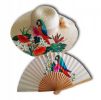The basic rules of painting
Seeing and looking
An onlooker sees a landscape, or a scene. An artist looks and sees beyond mere vision. It is from this exercise that the desire to paint is born. So, look, look and you will find a subject that will give you the irresistible urge to interpret it.
The composition
Prepare a fairly rigid piece of cardboard, about 20 cm long and 15 cm wide. Put in a window measuring 13 cm by 11 cm.
Hold your cardboard, prepared in this way, in front of you, between your directing eye and the subject you have chosen. Move it away from you, or bring it closer, until your subject is "framed", exactly as you would with a camera. You have your subject as it will be represented on canvas.
Don't rush your canvas. Pay attention to your instinct, your sensitivity. What made you choose this subject? What comes out of it, how do you see it? Do you see certain colors or shapes that inspire you?
Look at the same subject treated by different painters. Cézanne and Van Gogh. The subject is the same, and they're both Impressionists. The interpretations are no less different.
let's return to your painting.
the subject that attracts you is also your enemy. However beautiful it may be, it risks betraying you, and your work could turn the result into a postcard. Geometry is the basis of everything. It's the composition of the painting. It doesn't matter if it's not an exact reflection of reality. The subject attracts you, the painter's temperament must kill the subject.
It's the painter's personality and sensitivity that will allow him to play with colors or grays, and free the work from the subject. You see it as it is in your mind; all you have to do is reproduce it as you dreamed it.
André MALREAU has said that many people don't like painting, but they are sensitive to the subject that moves them: horses, boats, cats in baskets, etc.
The white canvas
|
The background You have two options:<br / - Start with a white canvas, i.e. a white background, - You start with an already prepared background. for the background, you already know the tone of your canvas. You know whether you'll be using cool tones, blues and greens, or warm tones, ochres, oranges, reds and browns. you can therefore paint your canvas entirely or partially, in the basic tones that will suit the mood of your painting. Drawing using charcoal on a white canvas or a paintbrush, draw the contours and relief of your subject in black or Prussian blue. Don't go into too much detail, you're just sketching. The painting First, prepare your palette. put on some of the primary colors you'll need, not forgetting black and white. Prepare the tones that will soon be on the canvas. You can start painting. <br / Remember: we spend more time with our eyes riveted on our subject, than on our painting.<br> Look, look at your subject.<br> From time to time, look at your palette. Be sure it's not more beautiful than the painting. </TD></TR></TABLE> <br> |


